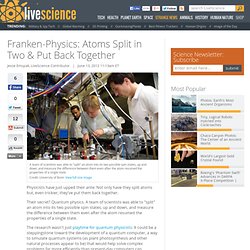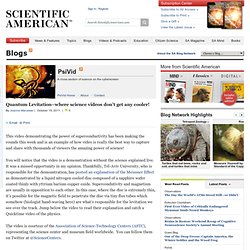

The Feynman Lectures on Physics. Stop Using Quantum Mechanics as Evidence for Magic. You Know How This Experiment Ends, But You Should Watch It Anyway. Kinja is in read-only mode.

We are working to restore service. First off, I have to marvel at how incredible this is to watch and admit that it made me too gawk, giggle, and grin like a child. I can't wait to show people this. That said, does anyone else wonder how much it had to cost to spend the 3 hours pumping out the air, setting up, and conducting this experiment that everyone know the result of? (Again, not wanting to rain on anyone's parade cause I'm damn glad they did it. What's Up With That: How a Swinging Pendulum Proves the Earth Rotates. Why is the sky blue? Blue skies make the heart soar and poets rush for quill and ink.

The blue dome has subtle variety. Overhead it is darker - noticeably so from mountains or airplanes. Near the horizon it pales almost to white. Why can't we get down to absolute zero? Weird! Quantum Entanglement Can Reach into the Past. Spooky quantum entanglement just got spookier.

Just how small is an atom? - fun TEDEd video. These gorgeous sand patterns were created by a few sounds. Antimatter Atom Measured for the First Time. Scientists have taken the first-ever measurement of an atom made of antimatter.

This measurement, though not very precise, represents a first step toward being able to study antimatter atoms in detail — a goal necessary for understanding why the universe is made of matter and not antimatter, its mysterious sibling. All particles of matter are thought to have antimatter partners with the same mass but opposite charge. When these pairs meet, they annihilate each other to become pure energy. Scientists think the universe contained equal parts of matter and antimatter just after the Big Bang, which is believed to have started everything 13.7 billion years ago.
Wacky Physics: New Uncertainty about the Uncertainty Principle. One of the most often quoted, yet least understood, tenets of physics is the uncertainty principle.

Formulated by German physicist Werner Heisenberg in 1927, the rule states that the more precisely you measure a particle's position, the less precisely you will be able to determine its momentum, and vice versa. Franken-Physics: Atoms Split in Two & Put Back Together. Physicists have just upped their ante: Not only have they split atoms but, even trickier, they've put them back together.

Their secret? Quantum physics. A team of scientists was able to "split" an atom into its two possible spin states, up and down, and measure the difference between them even after the atom resumed the properties of a single state. The research wasn't just playtime for quantum physicists: It could be a steppingstone toward the development of a quantum computer, a way to simulate quantum systems (as plant photosynthesis and other natural processes appear to be) that would help solve complex problems far more efficiently than present-day computers can. Leap Second Science: Earth's Longer Day Explained. Today will be one second longer than usual, and we have the moon to thank for the extra time.

A "leap second" will be added to the world's official clocks this evening (June 30), to account for the fact that Earth's rotation is slowing ever so slightly — meaning our days are getting longer, at the rate of about 1.4 milliseconds every 100 years. "At the time of the dinosaurs, Earth completed one rotation in about 23 hours," Daniel MacMillan, of NASA’s Goddard Space Flight Center in Greenbelt, Md., said in a statement. "In the year 1820, a rotation took exactly 24 hours, or 86,400 standard seconds. Newly Discovered Particle Appears to Be Long-Awaited Higgs Boson. Prepare the fireworks: The discovery of the Higgs boson is finally here.

Early in the morning on July 4, physicists with the Large Hadron Collider at CERN announced they have found a new particle that behaves similarly to what is expected from the Higgs. “As a layman, I would now say, I think we have it,” said CERN director-general Rolf-Dieter Heuer. “It’s a historic milestone today. I think we can all be proud, all be happy.”
Both CMS and ATLAS, the two main LHC Higgs-hunting experiments, are reporting a boson that has Higgs-like properties at a mass of 125 gigaelectronvolts (GeV) with a 5-sigma significance, meaning they are 99.999 percent confident of its existence. Científicos fotografían por primera vez la sombra de un átomo. Lo que vemos en la imagen es un hito conseguido por un grupo de investigadores de la Universidad de Griffith.

PhysicsCentralAPS. Quantum Levitation–where science videos don’t get any cooler! This video demonstrating the power of superconductivity has been making the rounds this week and is an example of how video is really the best way to capture and share with thousands of viewers the amazing power of science!

You will notice that the video is a demonstration without the science explained live. One-Minute Physics: Why GPS is just a clock in space. The Physics of Angry Birds. You know the game, I know you know. Angry Birds. One-Minute Math: Why you can't comb a hairy ball. Ultrafast Camera Records at Speed of Light. Researchers at the Massachusetts Institute of Technology (M.I.T.) have developed an imaging system that can acquire visual data at a rate of one trillion exposures per second–fast enough to produce a slow-motion video of a burst of light traveling the length of a one-liter bottle, bouncing off the cap and reflecting back to the bottle’s bottom.
As Ramesh Raskar, an associate professor in M.I.T.’s Media Lab, explains in the video below, a high-speed camera can capture the image of a bullet mid-flight. The M.I.T. camera can capture the movement of photons, which travel about one million times faster than bullets. Scientists create first free-standing 3-D cloak. Researchers in the US have, for the first time, cloaked a three-dimensional object standing in free space, bringing the much-talked-about invisibility cloak one step closer to reality. Whilst previous studies have either been theoretical in nature or limited to the cloaking of two-dimensional objects, this study shows how ordinary objects can be cloaked in their natural environment in all directions and from all of an observer's positions. Published Jan. 26 in the Institute of Physics and German Physical Society's New Journal of Physics, the researchers used a method known as "plasmonic cloaking" to hide an 18-centimetre cylindrical tube from microwaves.
Untitled. Wacky Physics: Why Do Particles Have Flavors? In this regular series, LiveScience explores some of the wildest, weirdest parts of our universe, from quantum oddities to hidden dimensions. The building blocks of matter — fundamental particles — come in many more flavors than the basic few that make up the atoms we're familiar with. Flavor is the name scientists give to different versions of the same type of particle. For instance, quarks (which make up the protons and neutrons inside atoms) come in six flavors: up, down, top, bottom, strange and charm. Particles called leptons, a category that includes electrons, also come in six flavors, each with a different mass. The Unusual Physics of Floating Pyramids. By Kate McAlpine, ScienceNOW Think floating pyramids are more metaphysics than physics? How to build a time machine. How the universe appeared from nothing. MacGregor Campbell, consultant. Brian Cox and Simon Pegg explain why atoms have so much empty space.
In Zero-G Static Electricity Walks On Water. Cambridge Digital Library - University of Cambridge. Quantum Entanglement Experiments Expand to Include 8 Photons. Scientists Move Closer to Creating an Invisibility Cloak. Do You Use GPS? Say “Thanks” to Norman Ramsey (1915–2011) Norman F. The Mysterious Physics of 7 Everyday Things. Natalie Wolchover, Life's Little Mysteries Staff Writer | October 05, 2011 04:27pm ET.
Why there is no such thing as empty space. Asteroid orbits modelled in a single atom - physics-math - 04 February 2012. One-Minute Physics: How wings really create lift. Sandrine Ceurstemont, editor, New Scientist TV How does air flow across a wing to generate lift? Why Does Our Universe Have Three Dimensions? Two Diamonds Linked by Strange Quantum Entanglement. One-Minute Physics: Why past and future are the same.
One Per Cent: Fastest ever camera captures light in a flash. What Would the Universe Be Like If There Were No Gravity? Why are atoms mostly empty space? Are we just a 3D hologram created by 2D information stored at the edge of the universe? Physics in a Minute: The twin paradox. Seven equations that rule your world - physics-math - 13 February 2012. Optical Effects of Special Relativity. Quantum Levitation. Levitation train. Controlled Quantum Levitation on a Wipe'Out Track. Quantum Levitation. Quantum Levitation Demonstration at North Museum.
Thin Film Physics. Time Cloak Hides Very Brief Events [Animation] Red-Green & Blue-Yellow: The Stunning Colors You Can't See.